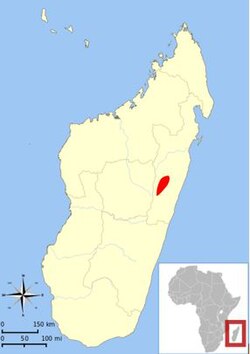Ecology and behaviour
The golden mantella is highly seasonal in its behaviour and remains largely inactive during the winter months of May–October. During the summer, the golden mantella is commonly active during the day. They live in groups of typically twice as many males as there are females. When the rains arrive and the temperature warms, frogs emerge from hiding and use small lentic wetlands for breeding. [2] Males often call from concealed positions near a water source. The call is a rather pleasant, repeated click. The frogs do not seem to engage in typical amplexus but rather the male only moves himself over the female's back in virtual amplexus. [6] Eggs are laid on land in moist leaf litter near water and when rains arrive the tadpoles are washed from land into water. [7]
The golden mantella has a diet of small invertebrates. [5] In the wild, this mainly consists of mites, ants, flies, and collembolans. [8] The frogs derive their skin toxins from their diet. These toxins include pumiliotoxin, allopumiliotoxin, homopumiliotoxin alkaloids, pyrrolizidines, indolizidines and quinolizidines. [7] Although poisonous, the snake Thamnosophis lateralis and a skink of the genus Zonosaurus have been observed preying upon this species at Torotorofotsy Wetland. [9]
In captivity
There are plans to launch a legal regulated collection program for this species. [1]
Showings from a 2017 study found significant difference in captive vs wild golden mantella behavioral response times in captive populations vs wild populations, favoring captive populations.
The golden mantella is occasionally seen in the pet trade and kept in captivity by exotic animal collectors and zoological institutions. They are popular due to their diurnal activity, attractive coloration and relative ease to keep when settled in. Care sheets are easily found for this species. On the downside, however, the golden mantella is critically endangered, and the population is decreasing.
This page is based on this
Wikipedia article Text is available under the
CC BY-SA 4.0 license; additional terms may apply.
Images, videos and audio are available under their respective licenses.



